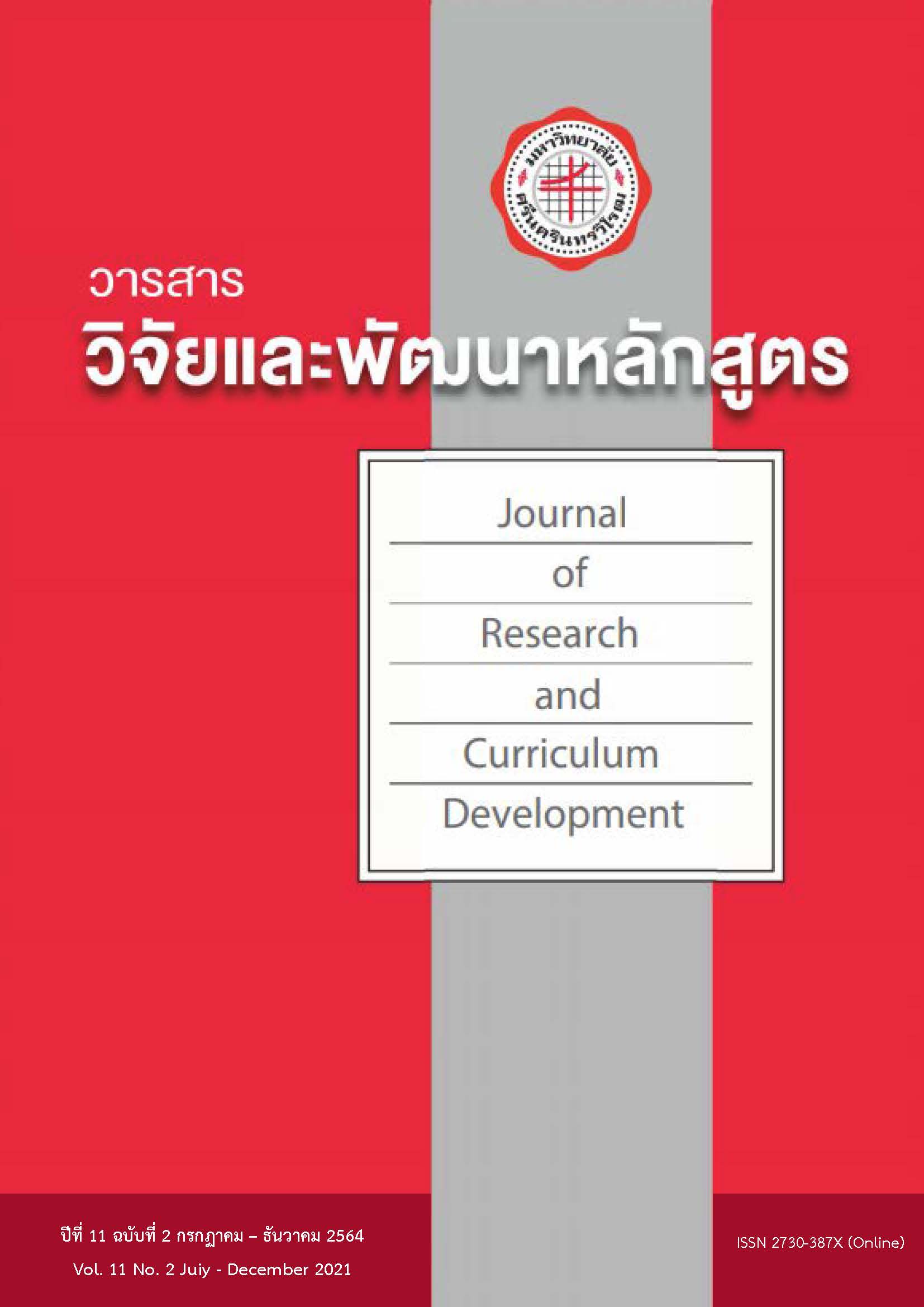การศึกษาข้อกําหนดของแฟ้มสะสมผลงานอิเลคทรอนิคส์ (E-portfolios) เพื่อใช้ในการจัดเรียนการสอน และการประเมินผลการเรียนรู้ของนิสิตระดับปริญญาตรี ในหมวดวิชาศึกษาทั่วไป มหาวิทยาลัยศรีนครินทรวิโรฒ
Keywords:
แฟ้มสะสมผลงานอิเลคทรอนิคส์, การประเมินผลการเรียนรู้, เครื่องมือในการเรียนการสอน, หมวดวิชาศึกษาทั่วไปAbstract
การวิจัยนี้มีวัตถุประสงเพื่อหาข้อกำหนด ในการตรวจสอบและกระบวนการสร้างแฟ้มสะสมผลงานอิเลคทรอนิคส์ (E-portfolios) รูปแบบการทดลองเป็นแบบผสานระหว่างการวิจัยเชิงคุณภาพและการวิจัยเชิงปริมาณโดยประชากรในการวิจัยประกอบด้วยนิสิตชั้นปีที่ 1 จำนวน 150 ที่ลงทะเบียนเรียนในวิชา SWU141 (ทักษะการรู้สารสนเทศ) และ วิชา SWU151 (การศึกษาทั่วไปเพื่อการพัฒนามนุษย์) ใช้กลุ่มตัวอย่าง 70 คน จากการเลือกแบบเจาะจง เครื่องมือที่ใช้ในการวิจัยประกอบด้วย แบบวิเคราะห์มาตรฐานคุณวุฒิระดับอุดมศึกษากับทักษะในศตวรรษที่ 21 แบบวิเคราะห์มาตรฐานคุณวุฒิระดับอุดมศึกษากับอัตลักษณ์ของมหาวิทยาลัยศรีนครินทรวิโรฒและแฟ้มสะสมผลงานอิเลคทรอนิคส์ ผลการวิจัยพบว่าข้อกำหนดของแฟ้มสะสมผลงานอิเลคทรอนิคส์เป็นข้อกำหนดที่ส่งเสริมให้การจัดการเรียนการสอนสำหรับหลักสูตรหมวดวิชาศึกษาทั่วไปของมหาวิทยาลัยศรีนครินทรวิโรฒ มีประสิทธิภาพประกอบด้วยข้อกำหนดดังนี้ 1) การเลือกเป้าหมายทักษะและจริยธรรมตามผลการเรียนรู้ 2) มาตรฐานคุณวุฒิระดับอุดมศึกษาและอัตลักษณ์ของมหาวิทยาลัย 3) การอบรมระยะสั้น (Workshop) และ 4) เกณฑ์การประเมินทักษะและจริยธรรม
References
taxonomy for learning, teaching, and assessing: A revision of Bloom’s Taxonomy of Educational Objectives (Complete edition). New York: Longman; 2001
Deming, W.E., (1950). Elementary Principles of the Statistical Control of Quality, JUSE.
Foley A. Adobe ePortfolio: Using ePortfolios to demonstrate growth and assess learning [White
Paper] [Internet]. 2008 [cited 2015 March 16]. Available from:
http://wwwimages.adobe.com/content/dam/Adobe/en/education/pdfs/acrobat-eportfolios-wp.pdf
Iamsupasit, S. Theory and technique in behavior modification. Bangkok: Chulalongkorn University;
2006.
Isniah, S; Purba, HH, & Debora, F. (2020). Plan do check action (PDCA) method: Literature review
and research issues. Jurnal Sistem dan Manajemen Industri Vol 4 No 1 July 2020, 72–81 Retrieved by March 30, 2021, from the following website: file:///C:/Users/TinyR3n/Downloads/2186-Article%20Text-7752-1-10-20200801.pdf
Ivannova A, Smrikarov A. The new generations of students and the future of e-learning in higher
education. In International Conference on e-Learning and the Knowledge Society-e-Learning ’09 [Internet]. 2009 [cited 2015 March 16]. Available from: http://www.iit.bas.bg/esf/docs/publications/thenewGenerationsStudentsFutureE-learningHigherEdu.pdf
JISC. Effective Practice with e-Portfolios [Internet]. Available from:
http://www.webarchive.org.uk/wayback/archive/20140614113958/http://
www.jisc.ac.uk/whatwedo/programmes/elearning/eportfolios/effectivepra
cticeeportfolios.aspx
Knight, JE, & Allen, S. (2012). Applying the PDCA Cycle to the complex task of teaching and
assessing public relations writing. International Journal of Higher Education Vol. 1, No. 2; 2012, Retrieved by March 30, 2021, from the following website: https://files.eric.ed.gov/fulltext/EJ1057213.pdf
Knoll Inc. What comes after Y?: Generation Z: Arriving to the office soon [Internet]. 2014 [cited
2015 March 16]. Available from: http://www.knoll.com/knollnewsdetail/what-comes-after-y-generation-zarriving-to-the-office-soon
Koutrakun S. Education Psychology. Bangkok: Chulalongkorn University; 2010.
Lorenzo G, Ittelson J. Demonstrating and assessing student learning with e-portfolios. Educause
Learning Initiative Advance Learning through IT Innovation [Internet]. 2005 [cited 2015 March 16]. Available from: http://www.educause.edu/library/resources/demonstrating-andassessing-student-learning-e-portfolios
Maruyama, T; & Inoue, M. (2021). Continuous quality improvement of leadership Education
program through PDCA cycle. China-USA Business Review, January 2016, Vol. 15, No. 1, 42-49. Retrieved by March 31, 2021. Available from: https://www.researchgate.net/publication/304453615_Continuous_Quality_Improvement_of_Leadership_Education_Program_Through_PDCA_Cycle
Nakazawa M, Matsuo K, Kato K, Nakamura J. Portfolio intelligence system for process-oriented
education for graduate students. 39th ASEE/IEEE Frontiers in Education Conference [Internet]. 2009 [cited 2015 March 16]. Available from: www.ieeexplore.ieee.org
National Chamber Foundation. The millennial generation research review [Internet]. 2012 [cited
2015 March 16]. Available from: http://www.uschamberfoundation.org/sites/default/files/article/foundation/MillennialGeneration.pdf
National Education Association. Preparing 21st century students for a global society: An educator’s
guide to the “Four Cs” [Internet]. 2009. Available from: http://www.nea.org/ tools/52217.htm
Paraskevas A, Sigala M. 4MAT-ting teaching for multiple learning styles. In CHME-12th Research
Conference [Internet]. 2003. Available from: https://www.academia.edu/168214/4MATing_
Teaching_for_Multiple_Learning_Styles
Ring G, Ramirez B. Implementing ePortfolios for the assessment of general education competencies.
International Journal of ePortfolio [Internet]. 2012 [cited 2015 March 16];2(1):87-97. Available from: http://www.theijep.com
Salt Lake Community College. Electronic portfolios at SLCC [Internet]. 2015 [cited 2015 March 16].
Available from: http://www.slcc.edu/gened/eportfolio/index.aspx
Srinakharinwirot University. Innovative Learning Center. General Education Objectives and Courses
Description. 2013
Srinakharinwirot University. Innovative Learning Center. Thai Qualification framework for general
education. 2013.
Thoughtful Learning. What are learning skills [Internet]. 2014. Available from:
http://thoughtfullearning.com/resources/what-are-learning-skills
University of New South Wales. Assessment toolkit: Assessing with ePortfolios [Internet]. 2003 [cited
2015 March 16]. Available from: https://teaching.unsw.edu.au/printpdf/535





